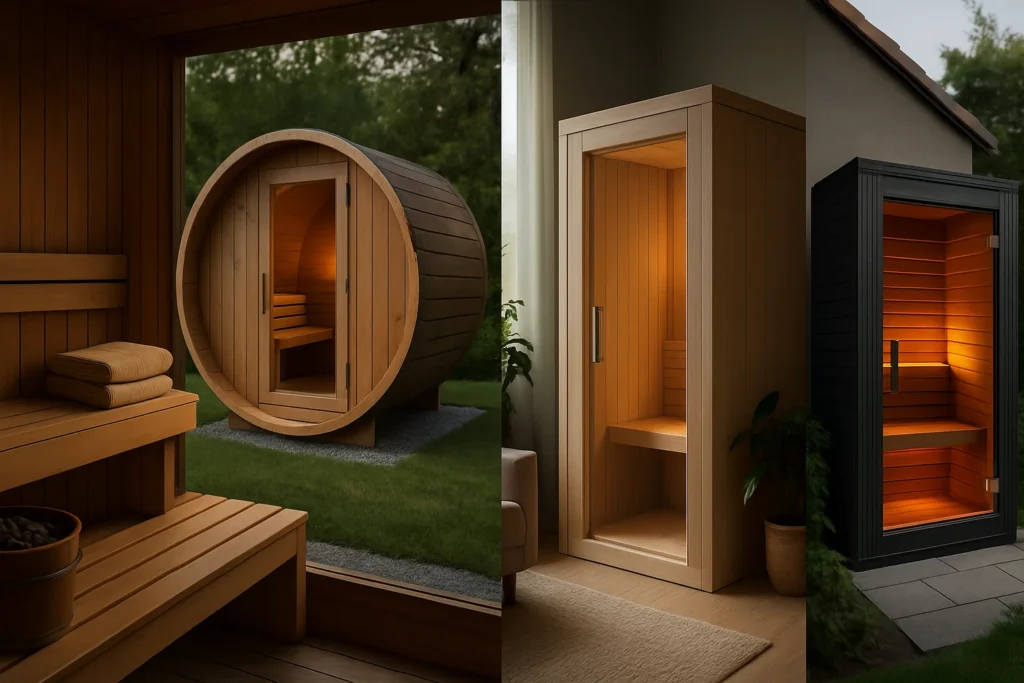The relaxing and health benefits of saunas have been well recognized for a long time. With these manifold advantages, today, more people are looking to add a sauna room at home so they can enjoy these benefits at their convenience. If you are wondering about the health benefits, cost, or how to build a sauna at home, this informative guide answers all your questions regarding the benefits of a sauna room at home.
Why Consider a Sauna Room at Home? (Top Benefits)
Having a sauna at home not only gives you the convenience of time, but also ensures you have the privacy that public saunas lack. You are able to unwind, detox, and improve your well-being whenever you wish. From traditional wood-burning saunas to modern infrared ones, different types cater to different budgets and spaces.
Health Benefits Of a Sauna Room
The most obvious reason is the boost to your health. Having a sauna at home allows you to relax and unwind. Using a sauna regularly can improve your cardiovascular health as it increases the heart rate and circulation, which is similar to moderate exercise. This can reduce blood pressure and, over time, strengthen your heart.
Stress Relief and Relaxation
Saunas have a warm, comforting atmosphere, which alleviates stress and increases relaxation. Stress hormones that lower relaxation and sleep quality are improved by the heat. This strengthens overall mood.
Detoxification
Sauna use leads to active Phyto Detoxification. You’ve likely heard of the phrase “sweat it out.”However, the use of saunas can aid in strengthening the immune system and improving skin health.
Convenience and Privacy
Owning a sauna means you can access its benefits at any specific time without having to travel to a gym or spa. That type of ease, paired with the sentimental comfort privacy provides, adds great value. You don’t have to compromise on hygiene while receiving spa-like services.
Home Sauna Options for Every Lifestyle

Traditional Saunas
The preferred versions of traditional saunas are ones that apply steam onto heated rocks. They need proper ventilation, and a special room is thus dedicated to providing a hot, sticky environment steeped in tradition.
Infrared Saunas
Infrared saunas utilize energy by using an infrared heater to warm your body at a lower air temperature. Because of their energy efficiency, they are much easier to install as well.
Portable Saunas
For renters or anyone with limited space, portable saunas are affordable and compact. Even though they are smaller, they still provide many health benefits and can be stored easily when not in use.
Home Sauna Sizes and Space Requirements
To guarantee comfort as well as effective functionality, consider size and placement of your sauna. A basic size of roughly 4 feet by 4 feet works well for a two-person sauna as it allows sitting without either person feeling cramped. If you plan on using saunas with family and friends, there are larger models available that can accommodate more users but will take up more space and require higher budget.
Consider your basement, bathroom, spare room and even outdoor areas like decks and backyards for sauna placement, as sunrooms can also be viable. Electric wiring and proper ventilation is vital for indoor installations, while outdoor saunas require harsh weather shielding and heating for protection from elements.
Careful collection of location measurements along with precise planning for sauna use will help determine its right size and ensure fitting placement in your home.
What Is the Cost of a Home Sauna?
Based on the type, size, and materials used, the cost for a home sauna varies widely:
| Category | Home Sauna Price Range |
| Portable Sauna | $300 – $1,000 |
| Small Residential Sauna | $2,000 – $5,000 |
| Custom Built Sauna | $5,000 – $15,000+ |
The total may increase for additional services such as electrical installations, ventilation, or maintenance. Infrared saunas tend to be cheaper and easier to install, while traditional saunas often cost more due to construction and ventilation needs.
DIY Home Sauna Construction
Picking the Hottest Spot
Ideally, you want to maximize proximity to electricity while staying in a room with good ventilation, such as a spare room, basement, or enclosed patio.
Picking the Right Sauna Materials
Select moisture and heat resistant woods for walls and benches such as cedar or hemlock for a nice aroma.
Options for Heating
Depending on your sauna type, you may have an electric heater or wood stove infrared panels. Observe local codes to meet safety regulations for all installations.
Last Elements And Ventilation
Proper safety & comfort require a correct aeration system. You want to make sure you’re installing benches, lights, as well as temperature control for a nice, ambient and serene environment.
Electricians and contractors ensure safety and compliance standards, making them ideal for bathroom sauna renovations.
Maintenance and Safety Guidelines
Regularly wash the sauna to avoid mold, mildew, and bacteria.
Do not use abrasive chemicals.
Sauna-safe cleaners have already been formulated for safe use in these environments.
Avoid overheating by keeping within the session length and the temperature monitored.
Drink enough fluids before and after using the sauna.
Have electrical parts and appliances checked and serviced regularly by qualified personnel.
Final Thoughts
The sauna room is effective in improving your health and comfort. In addition to physical health benefits, it also provides a relaxing oasis where you can relax. With proper planning of the design of your sauna, professional installation and regular maintenance, you can have this relaxing feature in your home and lifestyle for many years to come, making it a sound and worthwhile investment.
FAQs:
There are portable units for $300 and custom built residential saunas for over $15,000. These prices all depend on size and features.
A two person sauna is usually around 4 feet by 4 feet but can vary based on comfort preferences and available space.
Having their own sauna at home provides users with relaxation and health benefits while also offering privacy, making them valuable additions valued by many.
Yes, DIY sauna kits are available. Nonetheless, electrical and ventilation components require professional installation for safety reasons.
Home saunas can largely be split into two categories: traditional saunas which incorporate steam and heated rocks, and infrared saunas which apply heat directly to the body while keeping the surrounding air cooler.


